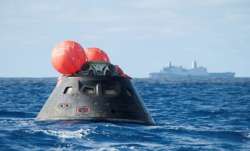Navy bringing back NASA's Orion after test flight
San Diego: A U.S. Navy ship carrying NASA's new Orion spacecraft was making its way to San Diego on Monday after retrieving the capsule from its Pacific Ocean splashdown point about 600 miles (965 kilometers)

San Diego: A U.S. Navy ship carrying NASA's new Orion spacecraft was making its way to San Diego on Monday after retrieving the capsule from its Pacific Ocean splashdown point about 600 miles (965 kilometers) southwest of the city.
The USS Anchorage was headed to Naval Base San Diego with the spacecraft, which parachuted into the ocean after a two-orbit, 4.5-hour test flight with no astronauts aboard.
Orion traveled 3,600 miles (5,800 kilometers) above Earth to test the spacecraft's systems before it carries astronauts on deep space missions. During re-entry into the atmosphere, the spacecraft endured speeds of 20,000 mph (32,000 kph) and temperatures near 4,000 degrees Fahrenheit (2,200 Celsius).
The spacecraft will be loaded onto a truck and returned to Cape Canaveral, Florida, just in time for Christmas.
Astronaut Suni Williams traveled aboard the USS Anchorage so she could observe the capsule's retrieval Friday from the Pacific Ocean. Williams has spent a total of 322 days in space, completing two expeditions on the International Space Station in 2007 and 2012. She was scheduled to speak to reporters about Orion's test flight late Monday in San Diego.
NASA and contractor Lockheed Martin Corp. assisted in Orion's recovery.
NASA is counting on future Orion missions to carry astronauts to Mars and beyond.
The next Orion flight, also unmanned, is four years away, and crewed flights at least seven years away given present budget constraints. But the Orion team—spread across the U.S. and on the ocean, is hoping Friday's triumphant splashdown will pick up the momentum.
During the flight test, all 11 parachutes deployed and onboard computers withstood the intense radiation of the Van Allen belts surrounding Earth. Everything meant to jettison away did so as Orion soared into space. It landed just a mile (1.6 kilometers) from its projected spot off Mexico's Baja Peninsula.
Data from 1,200 sensors inside and out of the crew module will be gathered to get the full picture of its performance.